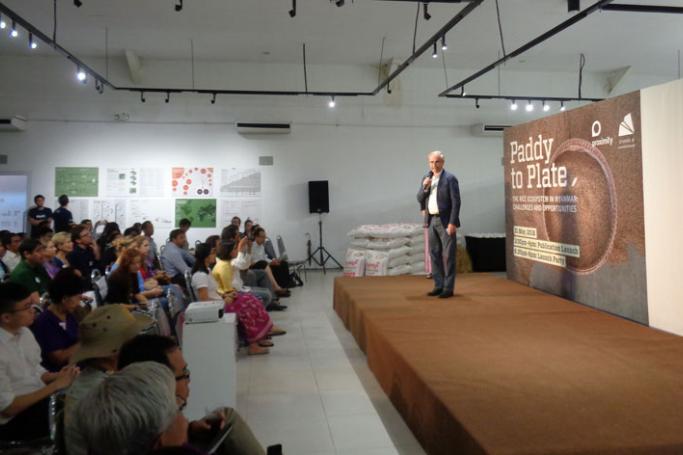Social enterprise Proximity Designs launched a report on 31 May titled ‘Paddy to Plate: the Rice Ecosystem in Myanmar,’ which aims to identify the roles at each stage of paddy production, the factors that drive decision making in the sales chain, and the opportunities and challenges facing a sector that is in a state of flux worldwide.
Creative director and writer Lauren Serota told Mizzima Weekly that the biggest challenge was “the breadth of the topic area and really doing it justice.”
“Rice in Myanmar is such a deep and significant thing. So much of the language is rooted in agricultural metaphors – it was really interesting to learn about the nuances. Our aim was to strike a balance between being thorough and interesting – we wanted to make something that rice nerds and consumers alike would enjoy reading,” she said.
The fact that it has been created by a team of designers and has a large visual component lends it to the category of coffee table book as well as presenting a body of qualitative research in an accessible way, said Proximity Design’s co-founder and Chief Executive Jim Taylor.
“We took a design lens to the rice sector; we wanted to use our research as a foundational study and complement existing macro-economic research,” he said.
Back in 1999, the International Rice Research Institute (IRRI) found that Myanmar has the highest annual consumption of rice at 211 kilogrammes per person per year. Laos, Cambodia, Vietnam and Bangladesh trail behind Myanmar’s consumption rates, despite being among the world’s top consumers. According to UNDO, rice eaters and growers constitute the bulk of the world’s poor.
When asked by Vicky Bowman of the Myanmar Centre for Responsible Business whether child labour had been found during the research process, Proximity’s project lead and writer Su Mon said that rice harvesting is “back-breaking, even for an adult. I don’t recall seeing any children working.”
“The thing that struck me the most is the interconnectedness of the process. It will take a systemic change from a lot of different players to get to the point where paddy farmers are at a level where they can consistently produce crops,” Ms Serota told Mizzima Weekly.
The launch was held at the Yangon Gallery in People’s Park and included a panel discussion featuring three rice experts, including Dr Duncan Bowden from Michigan State University. He presented a brief comparative analysis of Myanmar’s rice sector.
“There’s an amazing quote in the report… that says that [one of the researchers] didn’t meet a single young farmer who wasn’t frustrated. The future of the rice sector in Myanmar depends on changing that, so that young men and women do see a future for their families. Then rice will have a future.”
“Myanmar doesn’t need to worry too much about the international market – there is a strong demand for rice and competitors are struggling; they are struggling with issues such as climate change and the overuse of soils. But it is essential for Myanmar to make it profitable for farmers, and especially for young farmers.”
Fellow expert Daphne Khin Swe Swe Aye said that the government’s ad hoc policies of the past have held back the sector and contributed to high poverty rates amongst Myanmar’s agriculture workers.
“Suddenly there were no exports for months [following the floods during the last monsoon season] and then you lose the buyers. The government should not introduce ad hoc policies to solve problems in the short-term. There needs to be a longer term approach and more research needs to be done. And the research should be done on what farmers need – such as what types of seed they need – not what a minister likes to do. I hope the new government will do that. It is also very easy to say things, but implementation takes time. Schemes can be announced such as compensating farmers for losing crops, but there is no follow-through. The government should be really careful about announcing things before knowing whether they can be implemented.”
She also said that Myanmar should work towards creating its own unique variety of rice, rather than largely cultivating Chinese hybrids, as the costs of production tends to exceed profit margins.
The report is available for K20,000 from Proximity’s Yangon office – contact via its Facebook page. Or click here to download a free copy: http://www.proximitypublishing.org/paddytoplate
You are viewing the old site.
Please update your bookmark to https://eng.mizzima.com.
Mizzima Weekly Magazine Issue...
14 December 2023
Spring Revolution Daily News f...
13 December 2023
New UK Burma sanctions welcome...
13 December 2023
Spring Revolution Daily News f...
12 December 2023
Spring Revolution Daily News f...
11 December 2023
Spring Revolution Daily News f...
08 December 2023
Spring Revolution Daily News f...
07 December 2023
Diaspora journalists increasin...
07 December 2023
Tatmadaw and Arakan Army are in talks












